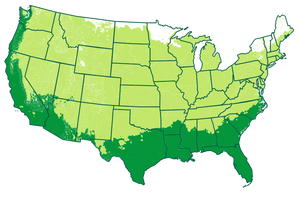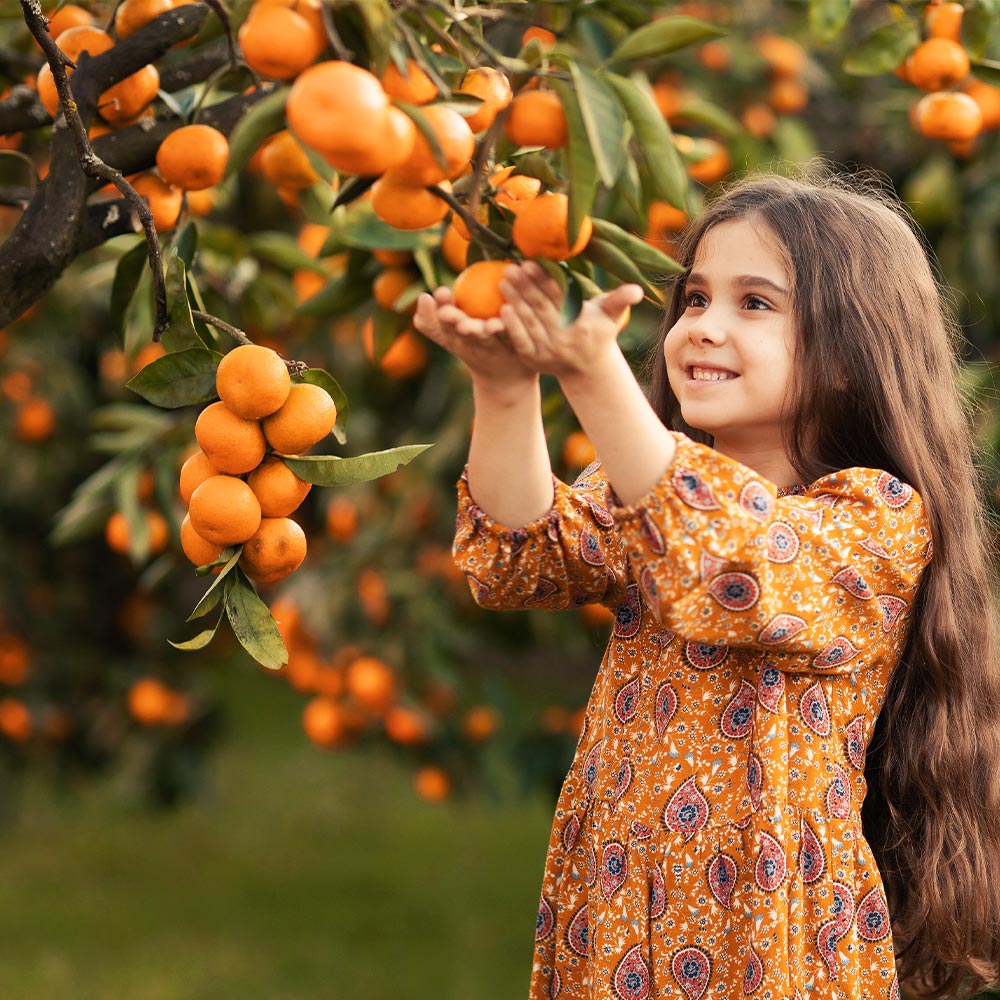* Images shown are of mature plants

Have questions? Talk with our Plant Experts (800) 973-8959
The Sweetest, Juiciest Orange
…that isn’t technically an orange. The Page Mandarin is a hybrid of Minneola tangelo and Clementine mandarin, so it’s officially a hybrid tangelo.
Once you taste this decadent, juicy, fruit, you won’t care how it’s classified and will most likely refer to it as The Best Orange Ever.
Packed with rich, sweet flavor, they’re an instant juicy treat picked right off the vine. Pages are strongly valued by many orange growers who claim they’re the best oranges for making orange juice.
One of the Easiest Oranges to Peel
The thin, leather-like rind makes the Page easy to peel. You can peel a couple of these delights in the same time you could most larger oranges.
The fruit is relatively small; about the size of a tangerine. The intense flavor makes up for the size. You’re not likely to find them at your grocery store, because their size makes them less profitable for the grocer than a larger size orange. You'll be able to offer your guests a treat they've likely never tasted before.
Jackpot!! You’ll Get a Long Harvest Season
Page Mandarins have a longer growing season than most citrus trees. Expect your tree to blossom in the spring. You’ll receive fruit as early as October and the fruit can hang on your tree through February.
Your plants will arrive with a strong root system equipped to thrive because we’ve nurtured them for you from 1 – 2 years already.
To get the maximum return, you’ll want to pair it with other pollinizer varieties. We’ve seen great success with the Pixie Mandarin as a pollinator.
Truly Fascinating Appearance
Their stunning appearance makes the Page a star in any setting. The dark green glossy foliage is accompanied by white flowering blossoms and rich orange-red fruit.
The color combination is alluring. If you want to put yours in a container and bring inside, you’ll be adding an inexpensive elegant touch to your décor. Plus, the aroma is intoxicating and will permeate the air throughout your home.
Versatile and Easy to Own
You can grow these plants in your orchard, in your yard, or in a container. This enthusiastic plant grows upright and spreads a bit because of the weight of the fruit.
- Low Maintenance
- Pruning is only necessary if you want to reduce the growth of the tree or thin the fruit production
- Very Few Thorns
No worries about the weight of a large harvest. This is one robust producer that accommodates the fruit until you’re ready to pick it.
A few Tips on Planting
If you plan to grow you Page Mandarins outdoors, choose a spot with full sunlight and in a wind protected area. Plants should be placed 6’ to 10’ apart.
If planting in a container, the pot should be 3 times the size of the root ball. The pot should be filled with a well-draining potting mix, and compost. Make sure your plant is placed in front of a window that gets plenty of sunlight.
Whether inside or out, you should water once or twice a week. Don’t overdo it. These do better in drought conditions than they do with inundation.
Pollination Info
Page Mandarin Tree Pollination
Page Mandarin Trees are self-fertile. You will get fruit with only one plant. However, adding an additional Page Mandarin Tree will drastically increase the size of your crop.
Planting & Care
The Page Mandarin (Citrus reticulata) is a small tree reaching a mature height of 8-10 feet and width of 4-6 feet. It does best in warmer climates and is recommended for USDA growing zones 8-11 when planting outdoors. If you’re in a colder zone, pot your mandarin tree and bring it indoors for the cold season, keeping it in a warm, sunny location. The Page Mandarin is a hybrid between the Minneola Tangelo and Clementine. Its dark, glossy green leaves are a beautiful contrast to the white flowers and small, orange-red fruit. Enjoy fruit as early as October and all the way through February. Their flesh is thin and leathery, but easy to peel which makes them easy to eat right off the tree. Their juicy, rich, sweet flavor is commonly used by orange growers for making the best orange juice. Pair your Page Mandarin with the Pixie Mandarin for the best pollination results.
Seasonal Information: Mandarin trees will do best in warmer climates as it is classified as a tropical plant. Zones 8 to 11 are ideal for outdoor planting. However, if you do experience cold winters, plant your mandarin tree in a container and bring it inside for the fall and winter seasons. We recommend planting in Spring through Fall for outdoors since they are sensitive to colder temperatures.
Selecting a location: Choose a location where your tree is going to get plenty of sunlight, 6-8 hours per day is best. They can tolerate some shade, but thrive in full sun. You’ll want to ensure trees are spaced properly if planting more than one. These trees also do better in areas with high humidity so you may also need to create humidity for your tree by misting the leaves daily with water. Potted plants do enjoy a daily misting for humidity but placing a tray with rocks filled with water under the plant will feed humidity to the tree as the water evaporates.
Planting Directions (in Ground): If you are located in zones 8-11 and your winter temperatures stay consistently warm, your mandarin will do well being planting outside in the ground. Be sure the area has well draining soil.
1) Dig a hole twice as wide and just as deep as the root system.
2) Place the tree in the hole and back fill it with your sandy, well drained, acidic soil. If you have clay soil, try amending it with sand, stone, perlite or fine potting soil.
3) Tamp the soil down as you backfill the hole to cut back on any pockets from forming.
4) After planting, be sure to give your mandarin tree a deep watering for about 5 minutes. Mulching around the tree will help insulate the roots and keep your plant warm in the colder winter months as well.
Planting Instructions (potted): If your winter temperatures are consistently below 40 degrees, plant your tree in a container that can easily be brought outside in the summer months and inside for the winter. A planter with built-in casters is a good choice so it can easily be moved. Choose a pot slightly larger than what it was shipped in (1-2 pot sizes) that has plenty of holes in the bottom to allow for drainage. Be sure to plant in well-draining potting soil preferably recommended for acid loving citrus plants.
1) Fill your pot halfway with soil. Remove the tree from its original pot and gently place it in the potting soil.
2) Fill in around the tree with the remainder of the potting soil but be sure not to cover the grafted area of the tree. Leave about an inch from the soil surface to the rim of the pot for easy watering.
3) Lightly pack down the soil. Immediately after planting, give your tree a deep watering until it flows from the holes in the bottom of the pot.
4) Place your tree in an area of your home, preferably a south-facing window, where it is going to get plenty of sunlight. Supplement with a grow light if it will not receive at least 6-8 hours of sunlight a day. You may also need to create humidity for your tree by placing the pot on a saucer of pebbles or misting the leaves daily with water.
Watering: Mandarins do not like wet feet. Be sure to give your tree a deep watering so that it can penetrate into the root system. After watering, allow the top 2-3 inches of the soil to dry out completely before watering again. Yellowing and droopy leaves is a common sign of over watering while brown, dry leaves are a sign of under watering. Mulching can help retain the soil moisture and also combat competing grasses/weeds.
For potted mandarins, stick your index finger into the soil down to about 2 inches. If there is moisture present, hold off on watering until it feels more dry at that depth. When ready to water, stop once you see it escaping the drainage holes at the base of the pot.
Pollination Assistance: You can pollinate your indoor trees by hand since most people do not keep a healthy bee population within their home. Simply take a small, dry, fine tipped paint brush and stick it into the center of the bloom. Swirl it around and collect the pollen on the brush. Go to the next bloom and repeat the process until every bloom has been treated. The bloom will fall off naturally and the fruit will begin to form.
Fertilization: Feed your mandarin tree during the warmer spring and summer seasons with a citrus specific fertilizer once every six weeks. Espoma Citrus Tone is highly recommended but any organic fertilizer specifically for citrus should suffice. This will help keep your tree on a healthy growth cycle but also replenish the nutrients in the soil. During the fall and winter season, ease back to fertilizing once every 2-3 months. Once the tree has matured a bit and has got a few years on it, you can skip the cold season fertilization. The same fertilizing regimen should be followed for potted mandarin trees as well. Make sure to follow the application instructions written on the fertilizer bag.
Pruning: Pruning can be done at any time of the year for in ground planted mandarins except in the winter. Make 45-degree angle cuts to remove dead or crossing limbs and also to thin out the tree to allow more light to flow between the branches. “Leggy” looking branches may indicate that there is not enough light getting to the tree’s interior. After the tree fruits, remove any dead wood and ventilate the center of the tree. Remove suckers as they form/grow from the base as they will steal away nutrients from the primary trunk of the tree. Pruning can be done at any time of the year for the potted mandarin.
Shipping Details
Estimated Shipping Time: Most orders ship immediately. As noted on the website, some items are seasonal, and may only ship in spring or fall. Once your order is shipped, you'll receive an email with a tracking number.
| Amount of Order | Shipping Charge |
|---|---|
| Less than $49 | $19.95 |
| $49 + | FREE SHIPPING! |
Product Details
| Mature Height: | 8 ft. pruned |
| Mature Width: | 4-6 ft. |
| Sunlight: | Full-Partial |
| Growth Rate: | Moderate |
| Harvest Time: | October - December |
| Year to Bear: | Can Fruit the 1st year! |
| Botanical Name: | Citrus reticulata |
| Does Not Ship To: | AZ,FL,GA,TX, AL |
| Grows Well In Zones: | 4-11 patio / 8-11 outdoors |
| Your Growing Zone: | # |







